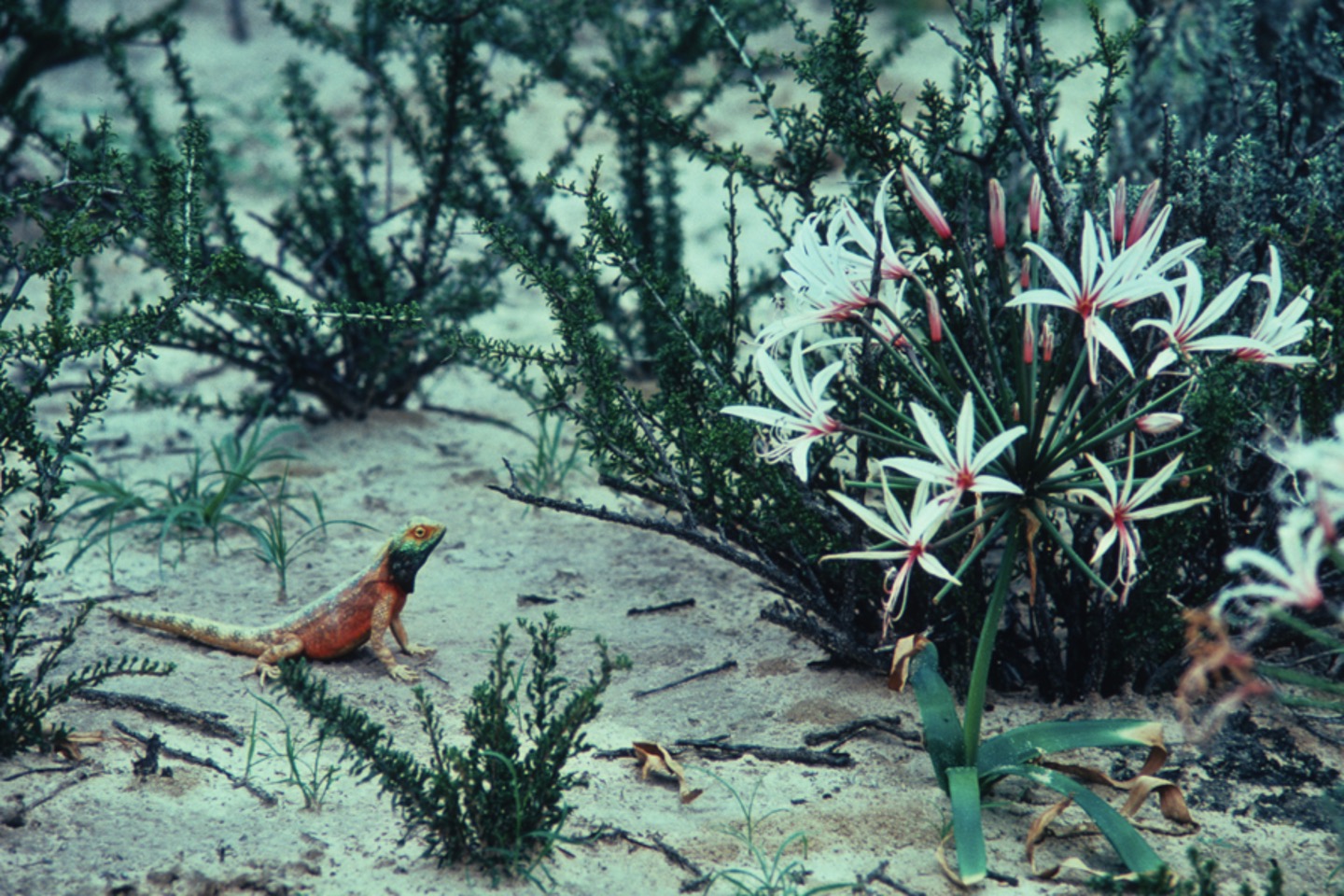36 Lizards bite back
While collecting geckos in the coastal desert of Peru in ’67 and ’68, I was routinely warned by Peruvians that geckos were dangerous. Some told me that being touched by a gecko’s toe would induce cancer or that their bite would cause a heart attack. There are many geckos in coastal Peru, and there are undoubtedly many cases of cancer and heart attack. However, could geckos cause cancer or other ailments? This seemed patently silly, as most geckos are small and harmless. This fear not just a Peruvian phenomenon; geckos are feared in many countries around the world.
Geckos are not the only lizards that are feared. An agamid lizard (Agama aculeata) in the Kalahari is believed to be venomous. Here the agamid’s enlarged canine teeth, which resemble small fangs, probably reinforce that belief. 
When I heard these warnings in the late 1960s, I thought they were nonsensical. I had been taught that the only venomous lizards in the world are the gila monster and the Mexican beaded lizard (close relatives). Consequently, I knew that geckos and agamids were harmless, but I would concede that some agamids and a few geckos could bite painfully.
In 1996, Eric Pianka and I were in the Gemsbok Park, checking the lizards we had captured earlier in the day. Eric was handling a big male Agama hispida, which was trying to bite him. One of the Park staff warned Eric to be careful because that species was venomous. One of us asked him, “Why do you think they are venomous?” The staffer responded:
“They don’t make their own venom, but they are venomous.”
Eric and I looked at each other, and one of us asked the obvious question,
Well, if they do not make their own venom, how can they be venomous?”
The man then explained that when he was a young boy, he had seen an agamid lizard with its head inside the mouth of a Cape cobra, a truly venomous snake. His interpretation was that the agamid was milking venom from the cobra. Our interpretation was that the agama was being swallowed by the cobra.
Without saying a word to each other, Eric and I both realized that in the absence of an observation at time “t plus one” – which would resolve whether the agamid walked away (favoring the staff person’s belief) or was swallowed (favoring our belief) – this disagreement could not be resolved. I knew intellectually that our interpretations of what we think we see are shaped to some extent by our personal, social, and political culture, but this real-life encounter made such cultural dependence very real. It was an obvious case of one event, two cultures, leading to two very different interpretations.
However, the story does not end in the Kalahari. In the early ’80s, Paul Hertz and I studied the thermal biology of agamid lizards from Israel (see Chapter 38). Paul had measured the field body temperatures of many lizards and flew to Seattle with lizards of several species. We raced these individuals at several temperatures and generated “thermal performance curves,” which quantify the thermal sensitivity of sprint speed. We then used these curves to evaluate, for example, whether high-altitude lizards had lower optimal temperatures for sprinting than did low-altitude lizards.
It was a great summer. Paul and I got beautiful data and wrote five major papers. Paul lived with Carolyn and me. His culinary skills and tastes are exceptional, as are his biological insights. The three of us had a special time.
During the racing experiments, Paul chased lizards down a narrow track with sidewalls; and I worked the computer and determined acceleration and maximal sprint speed. Two of the agamid species frequently bit Paul’s hand, and their enlarged canines often penetrated the flesh of Paul’s hands. After several weeks of chasing the lizards, Paul developed reactive arthritis in his hands. [Another aspect of this study is given in (Chapter 38)].

A few years later I received a letter from Joe Schall, who had been bitten by agamids during a research trip to West Africa. Joe also developed reactive arthritis in his hand. He had heard about Paul’s symptoms, which were similar to his.
We were excited because our observations suggested that bacteria in agamid saliva may have induced reactive arthritis. If so, agamid saliva might be used in medical studies to trigger reactive arthritis ‘on demand.’ We sent our idea to an expert in reactive arthritis, but received a rude response. We dropped this idea.
This story does not end with arthritis. Fast forward to the new century. Biologists were starting to use molecular tools to re-survey the occurrence of venom in lizards and snakes. New phylogenetic analysis conclusively showed that snakes were not evolutionarily separate from lizards but rather were derived directly from a family of lizards. In other words, snakes are a subgroup of lizards. Given that many snakes are venomous, this led to an obvious question: were some “traditional” lizards also venomous (beyond the Gila monster and the Mexican beaded lizard)?
In 2005, an international team discovered that several groups of lizards (including the Komodo dragon and an agamid lizard from Australia) had venom. A few years later, Fry et al. (2009) suggested that the venom of Komodo dragons might help kill prey: however, the function of venoms in other species remained unknown.
These data have forced a re-evaluation of our skepticisms about lizard venoms. I still cannot believe that most geckos are venomous (geckos do express venom genes, but that does not imply they are venomous), but a few do bite hard and might induce bacterial infections – though I have never heard of a validated case. Agamids do bite hard (Herrel et al., 2007) and their enlarged ‘incisors’ sometimes draw blood and might induce infections, as apparently suffered by Paul and Joe.
I am open to changing my views about lizards and venom. But even if Agama aculeata in the Kalahari is found to have an effective venom, I am not ready to accept the idea that agamids acquire that venom by milking cobras. But if that ever proves true, wouldn’t that be amazing? And I hope that David Attenborough would film it.